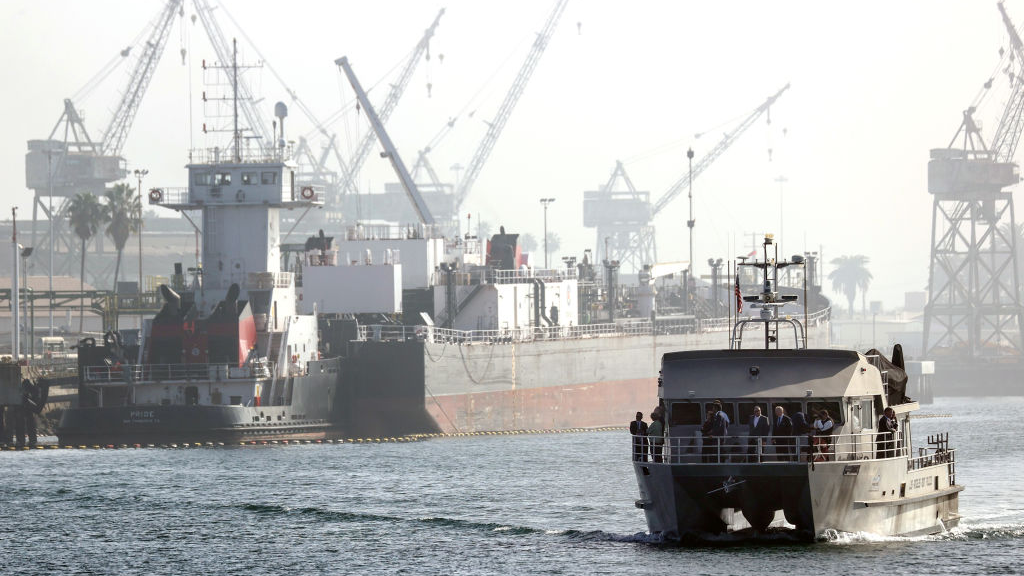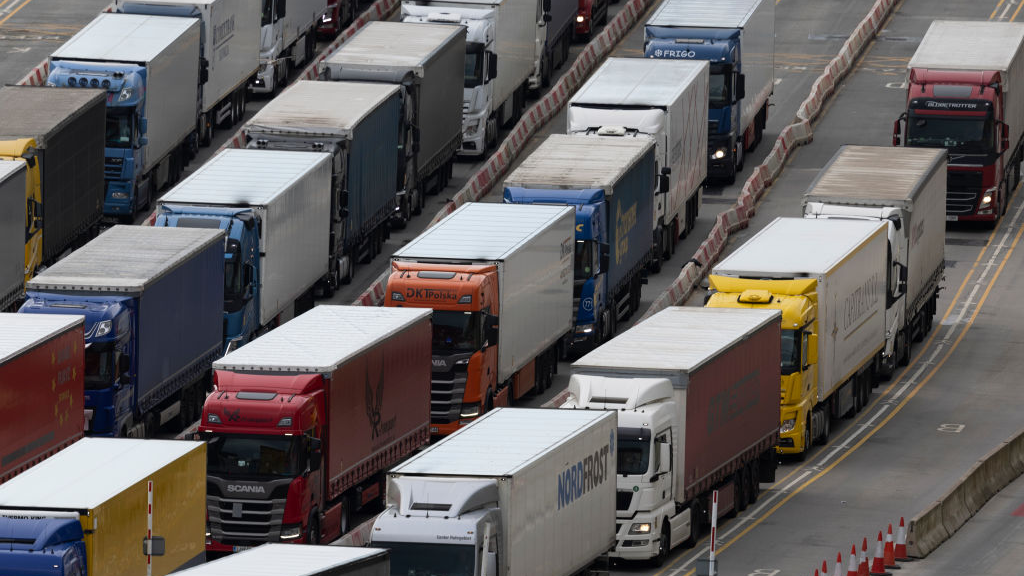
A boat carrying U.S. Secretary of Labor Marty Walsh and other officials to discuss initiatives aimed to ease disruptions in the supply chain tours the Port of Los Angeles in San Pedro, California, November 30, 2021. /Getty
A boat carrying U.S. Secretary of Labor Marty Walsh and other officials to discuss initiatives aimed to ease disruptions in the supply chain tours the Port of Los Angeles in San Pedro, California, November 30, 2021. /Getty
Editor's note: Djoomart Otorbaev is the former Prime Minister of the Kyrgyz Republic, a distinguished professor of the Belt and Road School of Beijing Normal University, and a member of Nizami Ganjavi International Center. The article reflects the author's views and not necessarily those of CGTN.
Despite forecasts of a rapid recovery in the global economy this year, it still faces several severe and unexpected challenges. No one anticipated that there would be a shortage of semiconductors or containers, an energy crisis and a record rise in natural gas prices, and now also significant problems in the global supply chain. Analysts warn that problems with global logistics and distribution will continue until 2023.
For a long time, logistics has evolved following lean production principles, first developed at Toyota and based on the maximum cost reduction. It reduces warehouses and parts storage times, minimizing labor and machinery to the level required to maintain stable and predictable production. But the lean manufacturing principles work well only during the steady economic growth phase.
The current crisis has revealed several trends that no one could have predicted. Initially, the spread of the pandemic led to a sharp halt in the world's economic activity. Besides, consumer demand fell sharply. This year, most countries returned to rapid economic growth.
The first signs of destabilization of supply chains appeared in the second half of last year. First, it seemed to be a temporary phenomenon, but the problem did not go away and, on the contrary, worsened. As a result, it expanded to a global scale. One of the most apparent aspects of the logistics crisis is the rising cost of transportation. According to Drewry Shipping Consultants, the average cost of sea transportation of a standard 40-foot container (FEU) is currently about $10,000. At the same time, over the past five years before the pandemic outbreak, it ranged from $1,000 to $2,000. One must remember that more than 90 percent of world trade is currently accounted for by sea transport.
As expected, the most significant increase in the cost of transporting happened on the most intensive routes from China to the U.S. and Europe. The cost of transporting FEU Shanghai - New York, which was about $2,500 in 2019, had grown to $15,000 by September. On an even busier route - from China to the U.S.' West coast - the cost of transporting a similar container reached $20,000. On the Shanghai - Rotterdam route, the cost of transporting one FEU container now costs about $14,000.

Freight moves through the Port of Dover in Dover, England, November 1, 2021. /Getty
Freight moves through the Port of Dover in Dover, England, November 1, 2021. /Getty
On the other hand, even with such high prices, the delivery times of goods have significantly increased. The most important U.S. and European ports face traffic congestion due to ships not being unloaded on time. The turmoil in the shipping industry and the broader supply chain crisis shows no signs of abating.
According to the non-profit Marine Exchange, Southern California recently hit an all-time high of 100 ships off the coast waiting to unload their cargo. As a result, the long-term idleness of vessels awaiting unloading in ports around the world is currently equivalent to the withdrawal from circulation of about 25 percent of the total capacity of the entire world container fleet. This further increases the delivery time, ships arrive at the port of destination with a delay, which further destabilizes the operation of ports, and the vicious circle is closed.
It is vital to understand the main reasons why the time to unload cargo, for example, through the most famous U.S. ports in 2021, increased by one-third? One reason is that the logistics sector is experiencing an unprecedented labor shortage. About half a million vacancies are open in the U.S. warehouse segment alone. Besides, the country lacks at least 80 thousand drivers. More than half of seafarers are from developing countries. This group lags in terms of vaccination rates, and therefore, following the new rules, it cannot fully work.
However, the rationale for the delays in delivering goods to consumers is the sharp increase in the volume of container traffic from China to the U.S. In the first seven months of this year, freight traffic between Asia and North America increased by 27 percent compared to the average pre-COVID-19 level.
In turn, the main reason for the boom in traffic was a colossal pumping of liquidity by central banks in the U.S., Europe and Japan. They launched an unprecedented monetary and fiscal stimulus to their economies in response to the economic recession caused by the pandemic. According to various estimates, additional money in circulation in these countries has exceeded $10 trillion since the pandemic. The expectation was that consumer demand would pull the economy out of the recession, but central banks have overdone it. The market jumped so strongly and sharply that the supply could not keep up with it.
The American economy was not ready for such a surge in demand. The rise in consumer demand in the U.S. increases imports. Their trade deficit has grown at a record pace. At the end of September 2021, it exceeded $80 billion, once again updating the historical maximum. For comparison, from 2010 to 2020, the U.S. trade deficit fluctuated between $40-50 billion.
As a result of unusually high demand for imports, freight prices between Asia and America skyrocketed. Before the pandemic, the maritime container shipping industry operated without reserve capacity, so the traffic growth caused an explosive increase in prices. The rise in prices for the transportation of goods in the Asian-American direction led to the fact that logistics firms redirected container ships and free containers from other routes to this destination. The crisis spread to all cargo transportation around the world. Likely, the situation will not improve next year either. Ordinary consumers will suffer as always.
(If you want to contribute and have specific expertise, please contact us at opinions@cgtn.com.)

